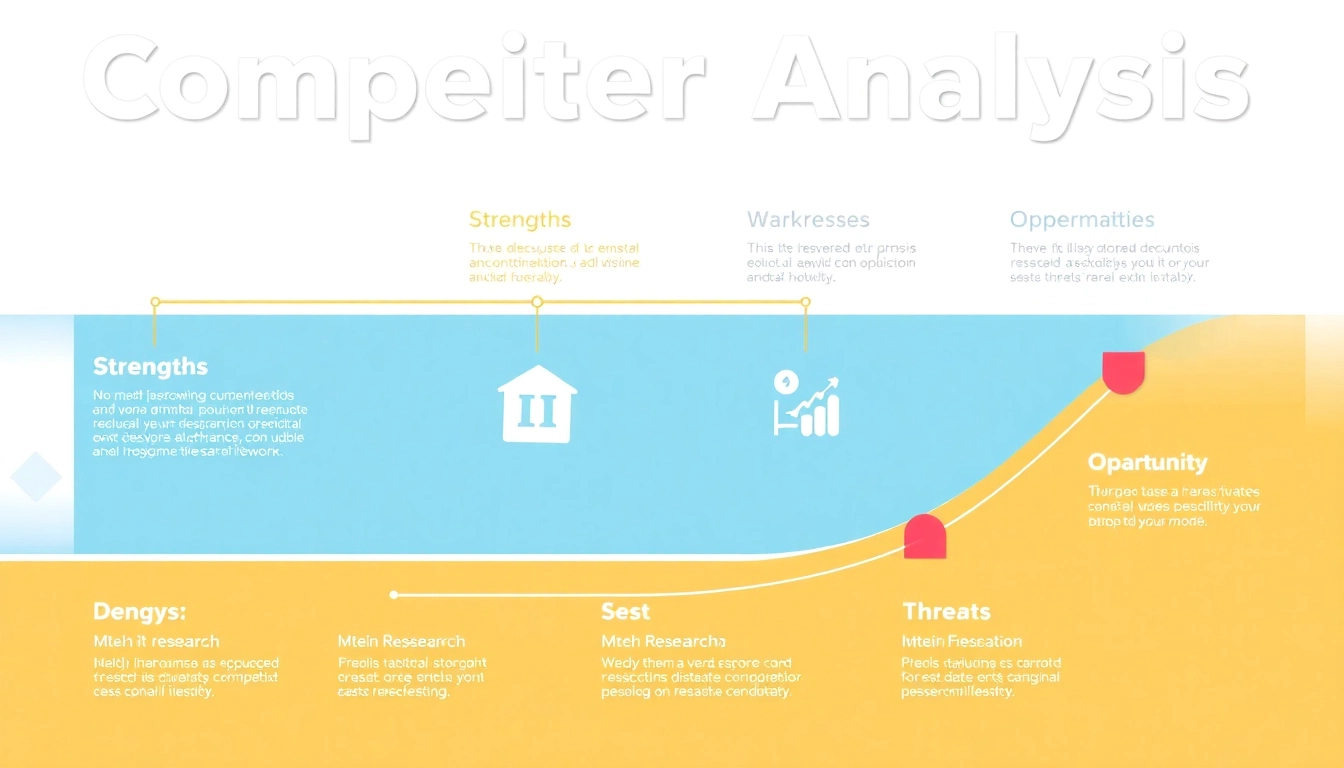Understanding Competitor Analysis
What Is Competitor Analysis?
Competitor analysis, also referred to as competitive analysis, is a systematic approach aimed at understanding the competitive landscape within a particular industry. The primary goal is to examine brands comparable to your own, offering insights into their product range, branding strategies, sales, and marketing approaches. This in-depth examination is essential for identifying market trends and helps businesses develop a robust competitive edge. Furthermore, it allows companies to refine their unique selling propositions (USPs) by contrasting their strengths and weaknesses against those of their competitors. In essence, competitor analysis is the foundational element in crafting strategies that will outperform rivals in any marketplace. For a detailed examination of methodologies in conducting a competitor analysis, further resources and case studies are invaluable.
Importance of Competitor Analysis
The significance of competitor analysis cannot be overstated. First, it helps businesses identify their direct and indirect competitors, revealing critical information that aids in strategic planning. By understanding who your competitors are and what they offer, you can better position your products or services and anticipate market shifts. Moreover, competitor analysis aids in recognizing consumer preferences and expectations, allowing for agility in marketing strategies.
Additionally, understanding competitor pricing, promotions, and unique offerings enables businesses to develop effective marketing strategies that resonate with target audiences. By leveraging insights gained during this analysis, companies can make informed decisions about product comparisons, branding efforts, and promotional strategies, thus optimizing marketing ROI.
Key Objectives to Achieve
The key objectives of conducting a competitor analysis can vary based on industry and business goals, but common objectives include:
- Identifying Gaps in the Market: Understanding where competitors excel or lack can uncover opportunities for your business.
- Benchmarking Performance: Measuring your performance against competitors establishes standards to meet or surpass.
- Informing Marketing Strategies: Insights from competitor campaigns can inspire your marketing approach.
- Enhancing Product Development: Learning about competitor offerings can spur innovation in your own products or services.
- Improving Customer Retention: Understanding competitor relationships with customers can guide enhancements to your own customer service models.
Steps to Conduct a Competitor Analysis
Identifying Your Competitors
The first step in conducting a thorough competitor analysis is identifying both direct and indirect competitors within your industry. Direct competitors offer products or services that are very similar to yours, while indirect competitors may serve the same customer needs in different ways. To effectively identify competitors, consider the following approaches:
- Market Research: Use industry reports and market research tools to gather data on key players.
- Search Engines: Conduct searches with relevant keywords to discover companies appearing in top positions.
- Social Media Analysis: Review social platforms to see which brands are gaining traction and engagement.
- Industry Events: Attend conferences and trade shows to observe key players and their innovations.
Gathering Relevant Data
Once competitors are identified, the next step involves gathering comprehensive data about their business. This can include:
- Website and SEO Analysis: Review competitor websites for their content strategy, layouts, and SEO tactics.
- Marketing Strategies: Study their advertising campaigns, social media tactics, and promotional giveaways.
- Customer Reviews: Analyze reviews and feedback on platforms like Google, Yelp, or TripAdvisor to gauge customer sentiment.
- Financial Performance: If available, look into financial reports, revenue benchmarks, and funding sources.
Utilizing tools like SEMrush, Similarweb, or Ahrefs can streamline this data-gathering process and provide insights into competitor traffic statistics and keyword performance.
Analyzing Competitor Strengths and Weaknesses
With data in hand, the next critical step is analyzing the strengths and weaknesses of each competitor. This process often involves creating a SWOT analysis (Strengths, Weaknesses, Opportunities, Threats) for each main competitor. When assessing their strengths, consider:
- Brand Reputation: How are they perceived in the market?
- Product Quality: Are their products or services highly rated by customers?
- Market Share: What portion of the market do they dominate?
- Innovation: Are they leading in research and development?
Conversely, evaluating weaknesses can reveal areas where you can differentiate your offerings:
- Customer Service Issues: Are there repeated themes in customer complaints?
- Poor Online Presence: Is their website outdated or hard to navigate?
- Lack of Engagement: Do they fail to engage with their audience on social media?
Tools and Resources for Competitor Analysis
Top Competitor Analysis Tools
To streamline and enhance the effectiveness of your competitor analysis, utilizing dedicated tools can substantially improve your research efficiency. Here are some leading tools commonly used:
- SEMrush: A powerful tool for keyword analysis, site audits, and competitive data.
- Ahrefs: Excellent for backlink analysis and SEO research, offering insights into competitors’ content strategies.
- Similarweb: Provides actionable insights on website traffic sources, user engagement metrics, and competitor benchmarking.
- BuzzSumo: Specializes in content marketing, showing you the most shared content in your industry and who’s sharing it.
Using Free and Paid Resources
Understanding that budget constraints may limit access to premium tools, there are also free resources available for competitor analysis:
- Google Trends: Use it to identify trends over time and geographical interest in your competitors.
- Social Media Insights: Platforms like Facebook and Instagram provide free analytics for businesses on engagement and demographics.
- Competitor Websites: Directly reviewing competitor websites can provide qualitative insights without needing software.
Combining these tools can provide a well-rounded view of the competitive landscape, enabling effective strategic adjustments.
Integrating Data into Your Strategy
Having gathered and analyzed all relevant data, the next step is integrating insights into your strategic planning. Here’s how to do this effectively:
- Define Goals: Use insights to set actionable goals, such as increasing market share or improving customer engagement.
- Update Marketing Tactics: Adjust marketing campaigns based on trends, pricing strategies, and promotional activities of competitors.
- Product Development: Incorporate feedback from competitor strengths and weaknesses to enhance your product lineup.
- Continuous Evaluation: Regularly revisit your competitor analysis to reassess positions and adapt strategies accordingly.
Common Mistakes in Competitor Analysis
Overlooking Indirect Competitors
A common pitfall in competitor analysis is solely focusing on direct competitors. Indirect competitors can offer valuable insights, as they may fulfill similar customer needs through alternative products or services. Failing to include these players can lead to missed opportunities for differentiation and market positioning.
Neglecting Consumer Trends
Consumer behavior is dynamic; thus, it’s essential to consider current trends while conducting analyses. A focus solely on competitor actions without factoring in changing consumer preferences can lead to strategies that miss the mark. Always analyze how competitors are responding to consumer trends and adapt accordingly.
Failing to Update Your Analysis
Markets are fluid, and competitors will continuously adapt. Therefore, failing to regularly update your competitor analysis can hinder your ability to remain competitive. Set a schedule for periodic reviews (e.g., quarterly or bi-annually) to ensure your insights stay relevant and actionable.
Measuring Success After Competitor Analysis
Setting Performance Indicators
To evaluate the effectiveness of your new strategies derived from competitor analysis, it’s vital to establish key performance indicators (KPIs). These might include:
- Market Share Growth: Monitor the change in your market presence relative to competitors.
- Sales Metrics: Track sales increases, revenue growth, and customer acquisition rates.
- Brand Engagement: Use analytics to measure engagement rates across marketing channels.
Reviewing Your Competitive Position
Regularly reassessing your competitive position is crucial. This involves not only comparing your performance against competitors but also gauging how market dynamics affect your standing. A review could involve SWOT analyses, benchmarking against established KPIs, and re-evaluating strategic goals.
Adapting Strategies Based on Insights
Lastly, the insights gained from ongoing competitor analysis should feed back into your business strategy. Be prepared to make changes to product lines, marketing approaches, or customer engagement methods. A proactive use of competitive insights will enhance your business’s adaptability in a constantly evolving marketplace, ensuring long-term success.



